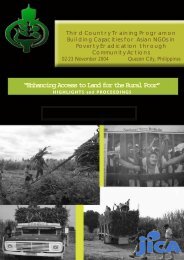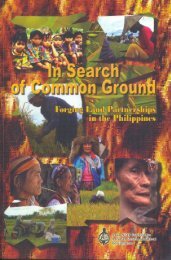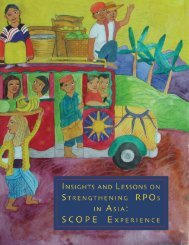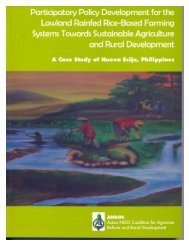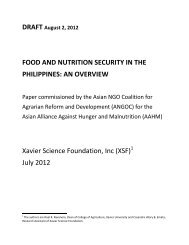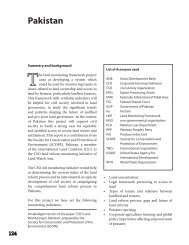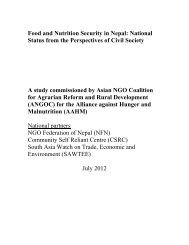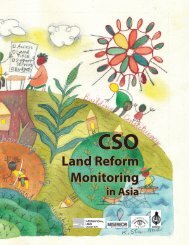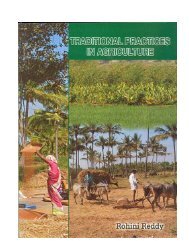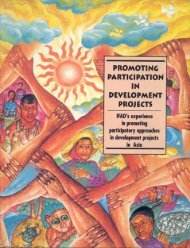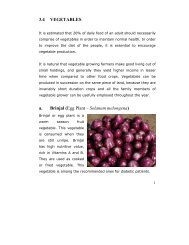Securing the Right to Land FULL - ANGOC
Securing the Right to Land FULL - ANGOC
Securing the Right to Land FULL - ANGOC
Create successful ePaper yourself
Turn your PDF publications into a flip-book with our unique Google optimized e-Paper software.
SECURING THE RIGHT TO LAND114<br />
There are an estimated 60,000 Haliya families in <strong>the</strong> hills of <strong>the</strong><br />
Mid and Far Western regions, and 300,000 in <strong>the</strong> western, central<br />
and eastern Terai districts in <strong>the</strong> country. These Haliya/<br />
Haruwa are mostly Dalits. Likewise, <strong>the</strong>re are over 30,000 former<br />
bonded laborers in five Terai districts of <strong>the</strong> Mid and Far Western<br />
regions of Nepal who have been living miserably for ages.<br />
Figure 1. <strong>Land</strong>-based Hierarchy in Terai<br />
Hatway (subordinate<br />
of Munsi)<br />
Charuwa (looks<br />
after cattle)<br />
Tahalu (serves food <strong>to</strong><br />
laborers)<br />
<strong>Land</strong>lord<br />
Munsi (record-keeper)<br />
Laguwa (moni<strong>to</strong>rs<br />
agrarian laborers)<br />
Haruwa (plougher)<br />
Mettar (sweeper)<br />
State/politics<br />
Market<br />
Social position<br />
Jan (paid agriculture<br />
laborer)<br />
Figure 1 illustrates <strong>the</strong> land-based social hierarchy in Nepal,<br />
especially in <strong>the</strong> Terai region. This hierarchy supports some of<br />
<strong>the</strong> most exploitative feudal practices. The landlord hires many<br />
groups of workers <strong>to</strong> plough his land, look after his cattle, work<br />
on <strong>the</strong> farm, take care of <strong>the</strong> animals and sweep <strong>the</strong> grounds.<br />
The figure also shows how <strong>the</strong> land-based bonded system is organized,<br />
particularly in <strong>the</strong> household as a production unit. The<br />
landlord continuously maintains his relationship with state, local<br />
or national political organizations, <strong>to</strong> secure power and authority. It<br />
is often <strong>the</strong> case that most elected representatives are <strong>the</strong>mselves<br />
landlords or close kin <strong>to</strong> <strong>the</strong>m. At <strong>the</strong> same time, a landlord also has<br />
<strong>to</strong> maintain linkages with <strong>the</strong> market <strong>to</strong> buy and sell products required<br />
for production. The market favors landlords because of <strong>the</strong>ir<br />
connection with state or political authorities. Fur<strong>the</strong>r, in one way<br />
or ano<strong>the</strong>r <strong>the</strong>y can ensure <strong>the</strong> continuous flow of commodities<br />
demanded in <strong>the</strong> market. They also maintain a social persona, by<br />
performing some kind of social work (e.g., as chair of a school<br />
management committee), by being benevolent <strong>to</strong> <strong>the</strong> poor, regularly<br />
performing religious rituals, and giving donations <strong>to</strong> charity<br />
organizations (such as for <strong>the</strong> construction of a temple), etc.<br />
<strong>Land</strong> Ownership and Distribution<br />
<strong>Land</strong>lessness<br />
According <strong>to</strong> <strong>the</strong> 2001 census, out of a <strong>to</strong>tal of 4.2 million<br />
households, 1.3 million households (or 25% of <strong>the</strong> populations)<br />
are landless (CBS, 2001).<br />
According <strong>to</strong> <strong>the</strong> Human Development Report of 2004:<br />
> In rural areas, almost 29% of households, or over 5.5<br />
million rural-based Nepalese (given that <strong>the</strong> average<br />
household size of Nepal, according <strong>to</strong> <strong>the</strong> 2001 census,<br />
is 5.45), do not own any farmland.<br />
> The marginalized groups include freed bonded laborers<br />
(about 26,000 families); landless peasants; squatter<br />
settlers; indigenous peoples; Haliya (300,000 persons);<br />
Haruwa/Charuwa; Dalit (22%); Badi/Badini (4,442 persons);<br />
and most indigenous and minority groups such as<br />
Chepang (52,237 persons); Mushahar (172,434 persons);<br />
Santhal, Jhangadh, Munda and many internally<br />
displaced people, Deukis (virgin girls offered for <strong>the</strong> service<br />
of a temple) and so on.<br />
Over 70% of peasants own less than a hectare of arable<br />
land (Nepal National Planning Commission, 1998).<br />
There is a huge gender disparity in <strong>the</strong> number of male and<br />
female landholders. Only 8.1% holders are female, though <strong>the</strong><br />
proportion is gradually improving (CBS, 2004). The lower proportion<br />
of female holders is directly related <strong>to</strong> <strong>the</strong> lower proportion<br />
of female household heads. Also, only 10.8% of women<br />
own land (Nepal National Planning Commission, 1998).<br />
Some 217,000 families do not have enough land on which<br />
<strong>to</strong> build a house. These are considered <strong>the</strong> agricultural landless.<br />
<strong>Land</strong>lessness is highest in <strong>the</strong> Terai districts.<br />
Size of Holdings and Distribution<br />
<strong>Land</strong>holdings less than a hectare in size make up close <strong>to</strong> 75%<br />
of <strong>the</strong> country’s farmlands, yet, <strong>to</strong>ge<strong>the</strong>r, <strong>the</strong>y account for less<br />
than 40% of <strong>the</strong> <strong>to</strong>tal farm area. On <strong>the</strong> o<strong>the</strong>r hand, big farmlands<br />
(5 hectares and over) comprise less than 1% of all holdings,<br />
but cover more than 7% of <strong>the</strong> <strong>to</strong>tal farm area.



